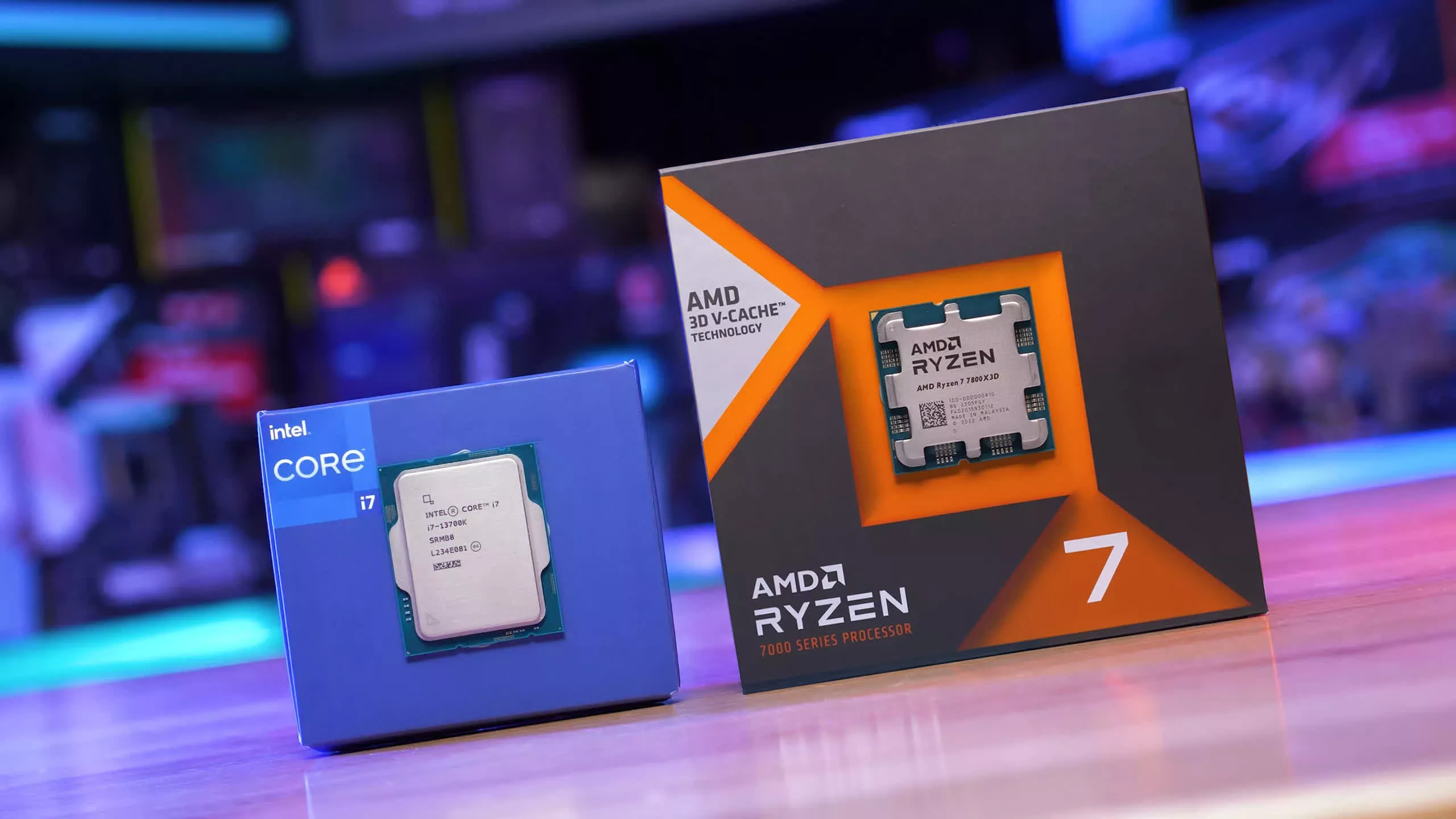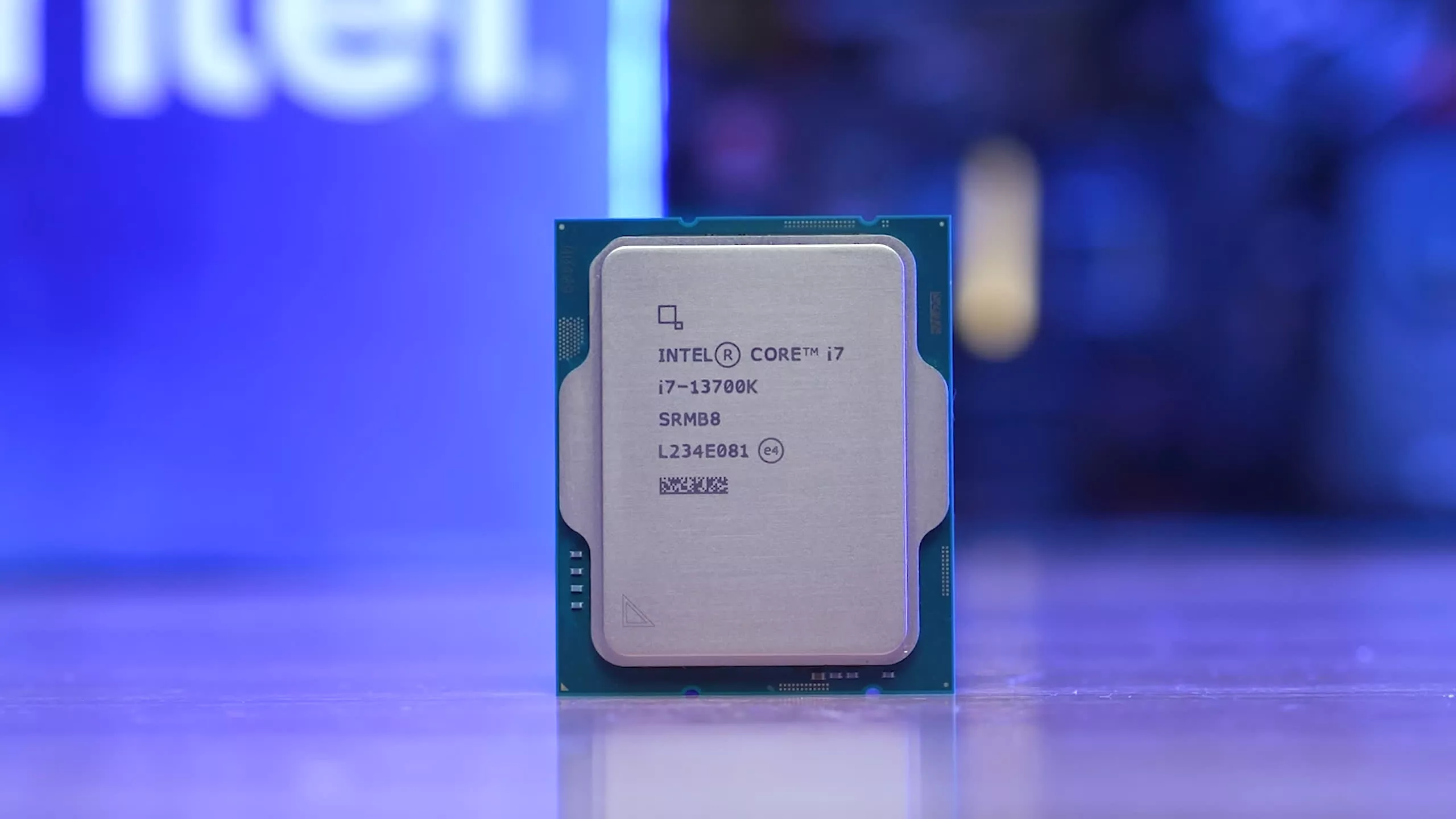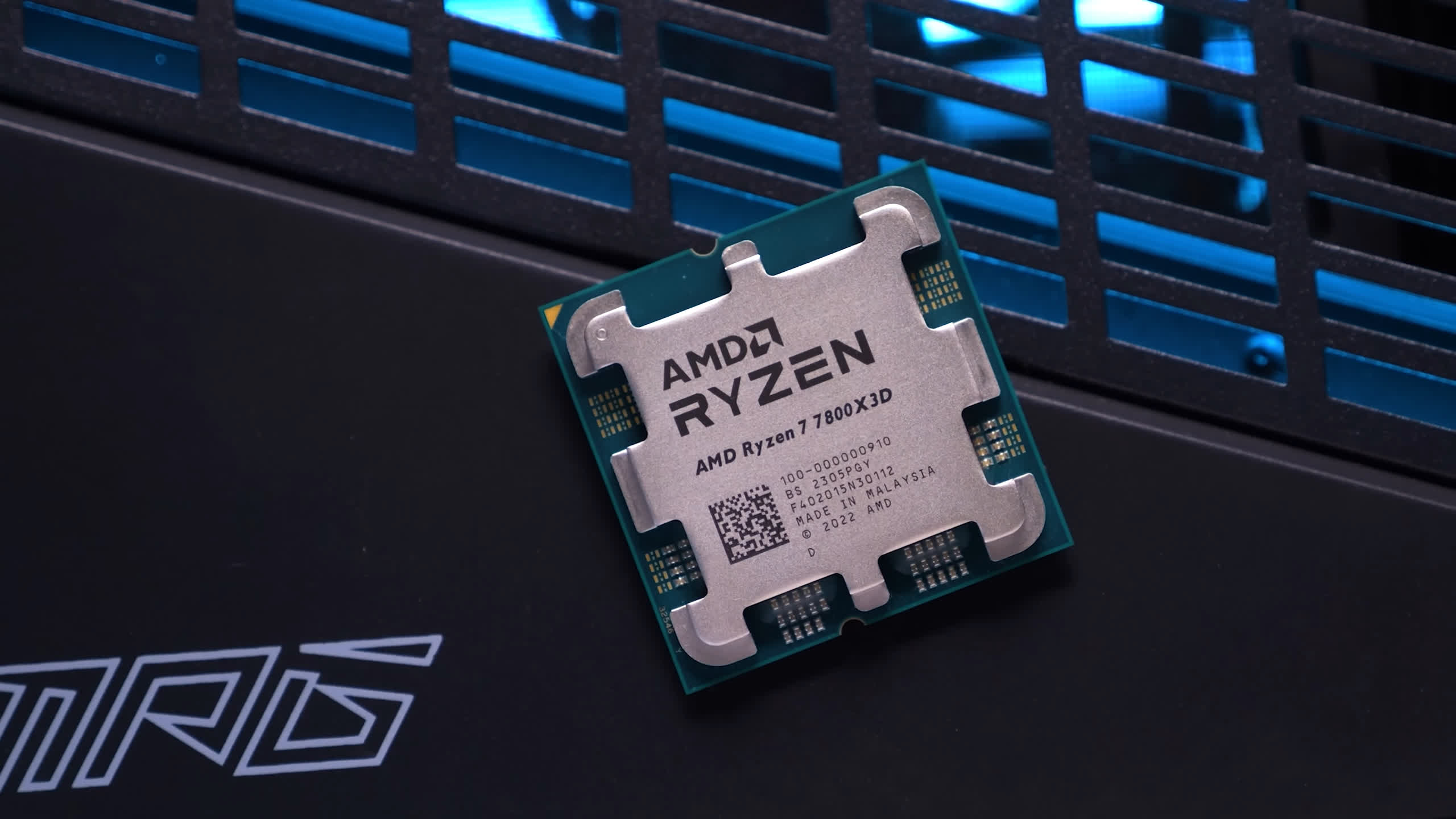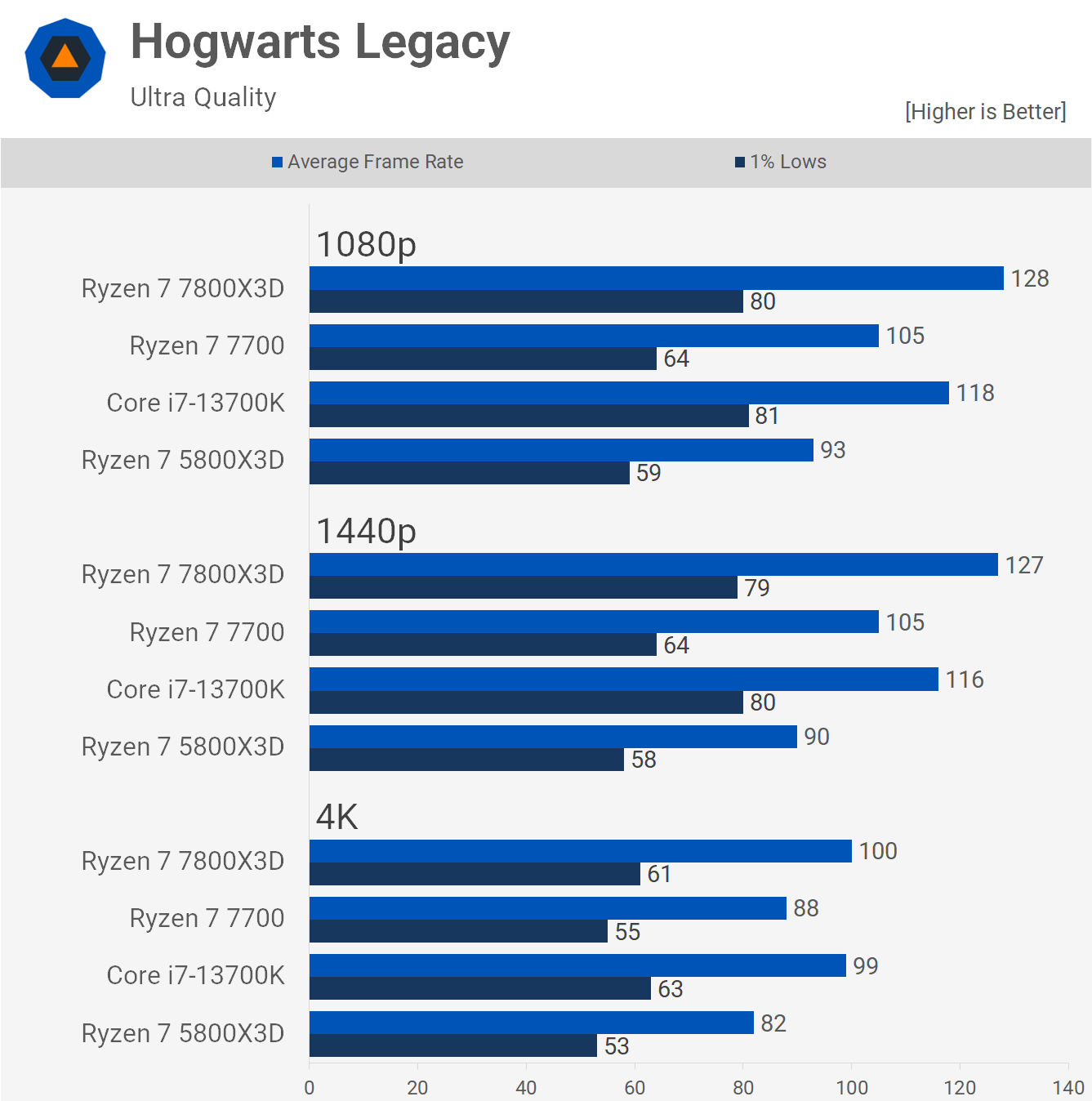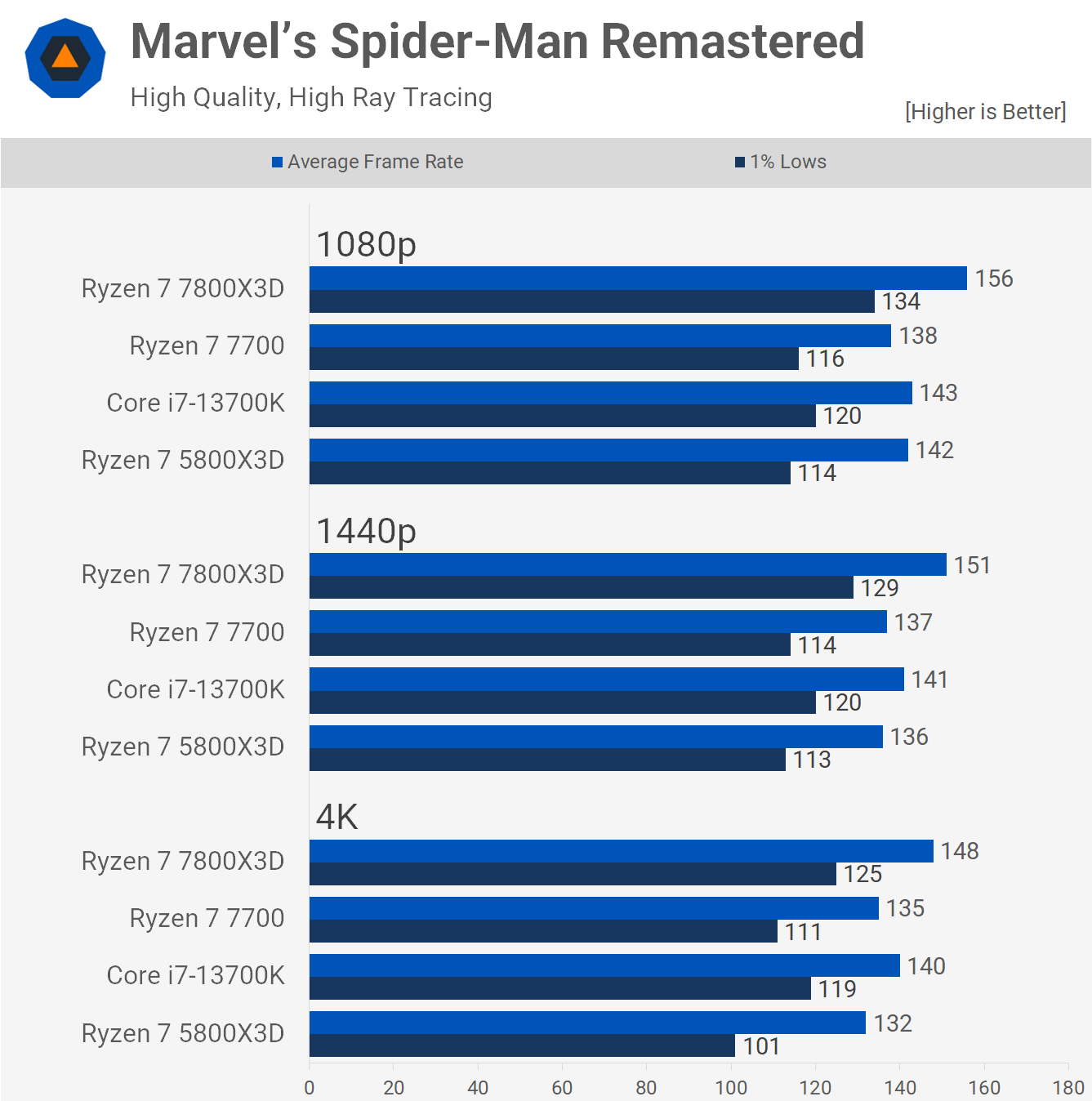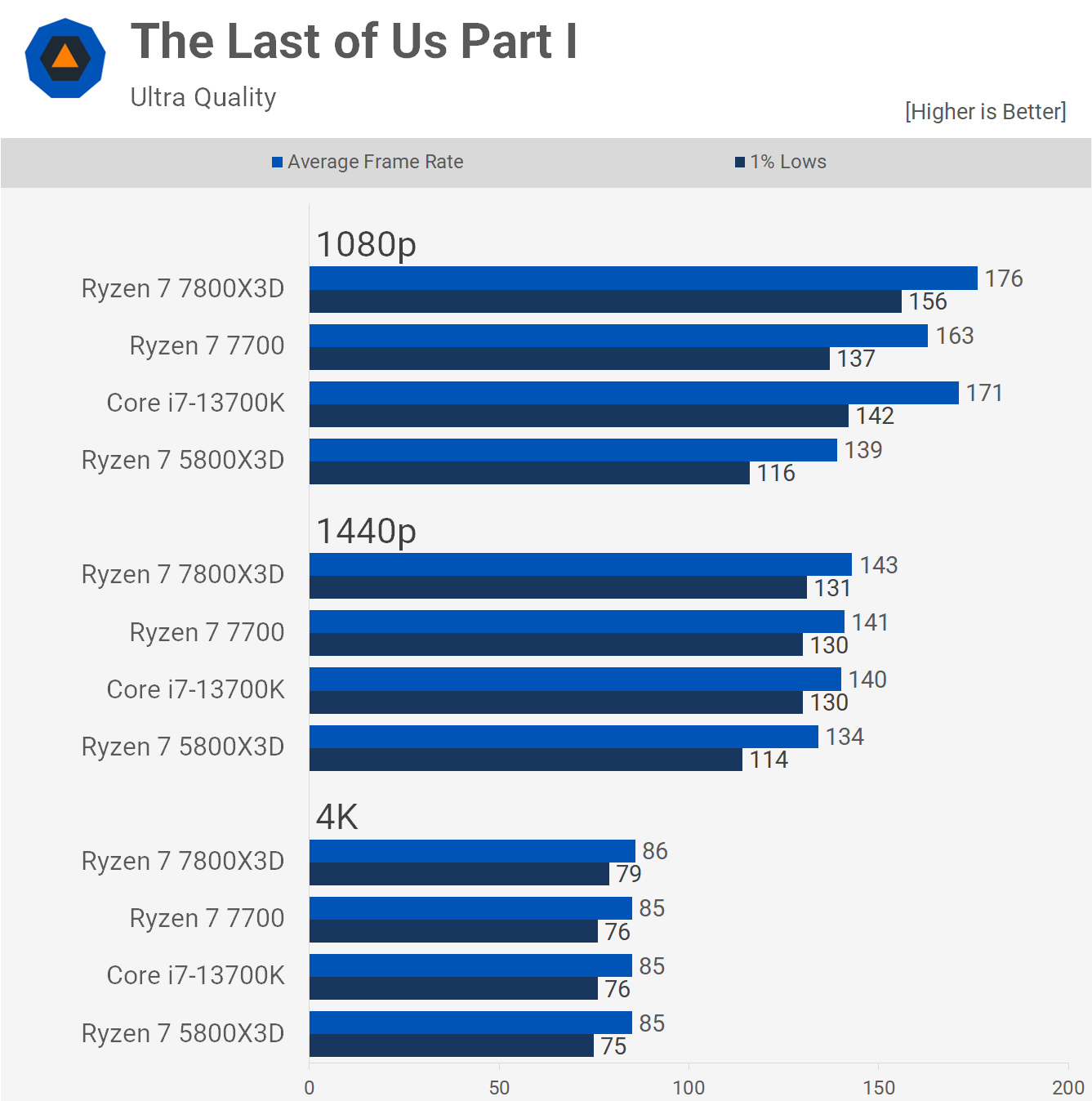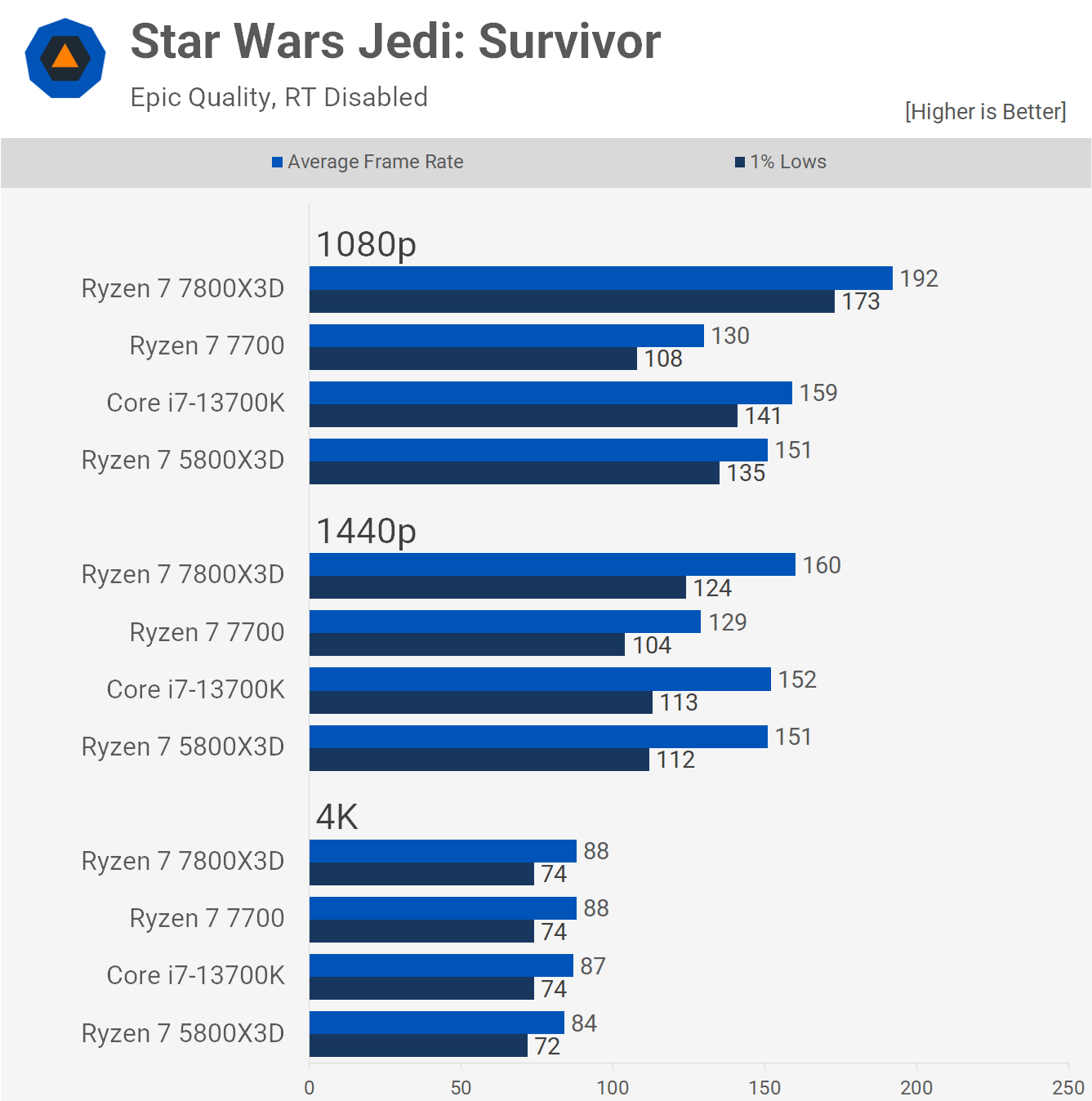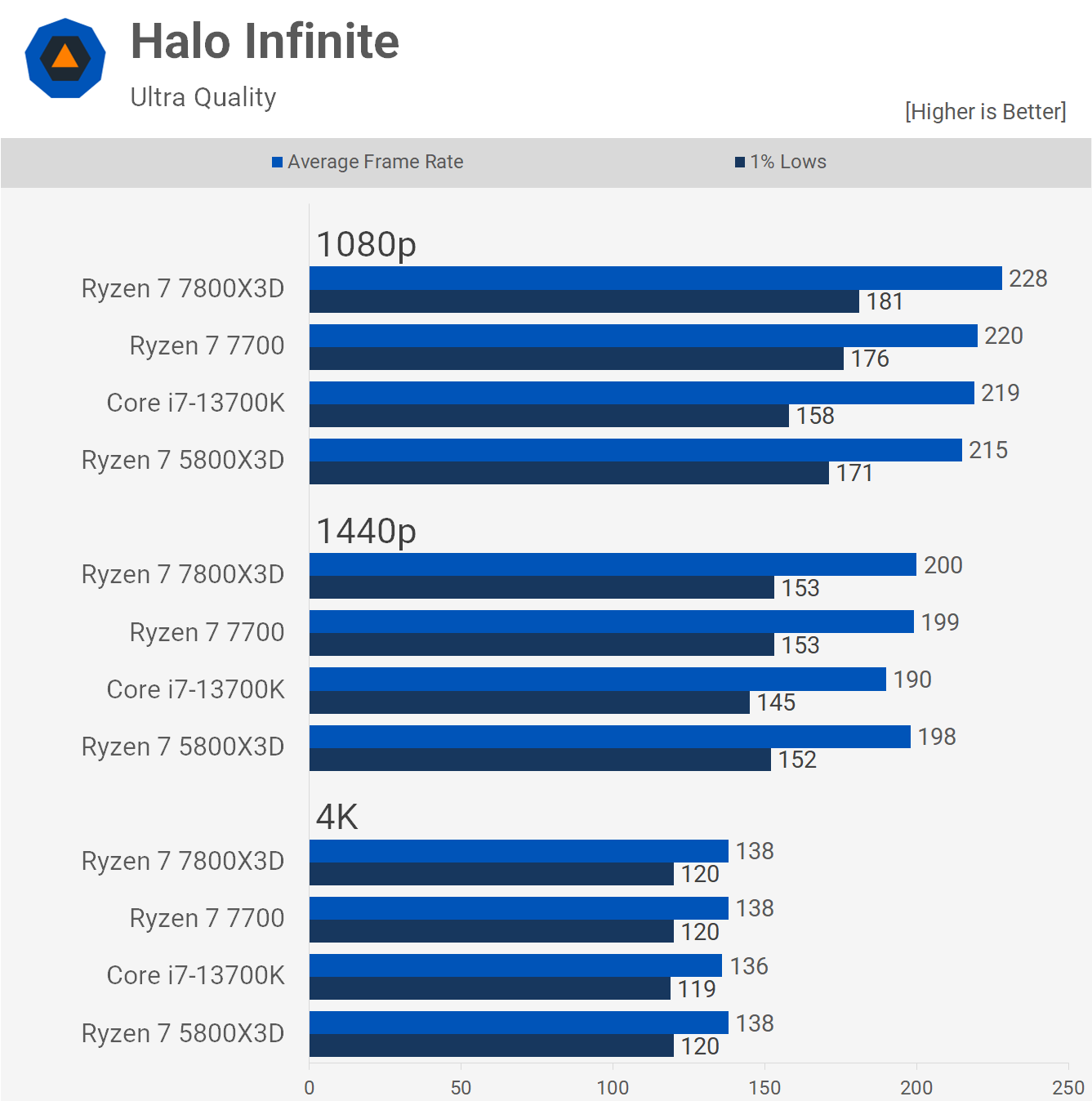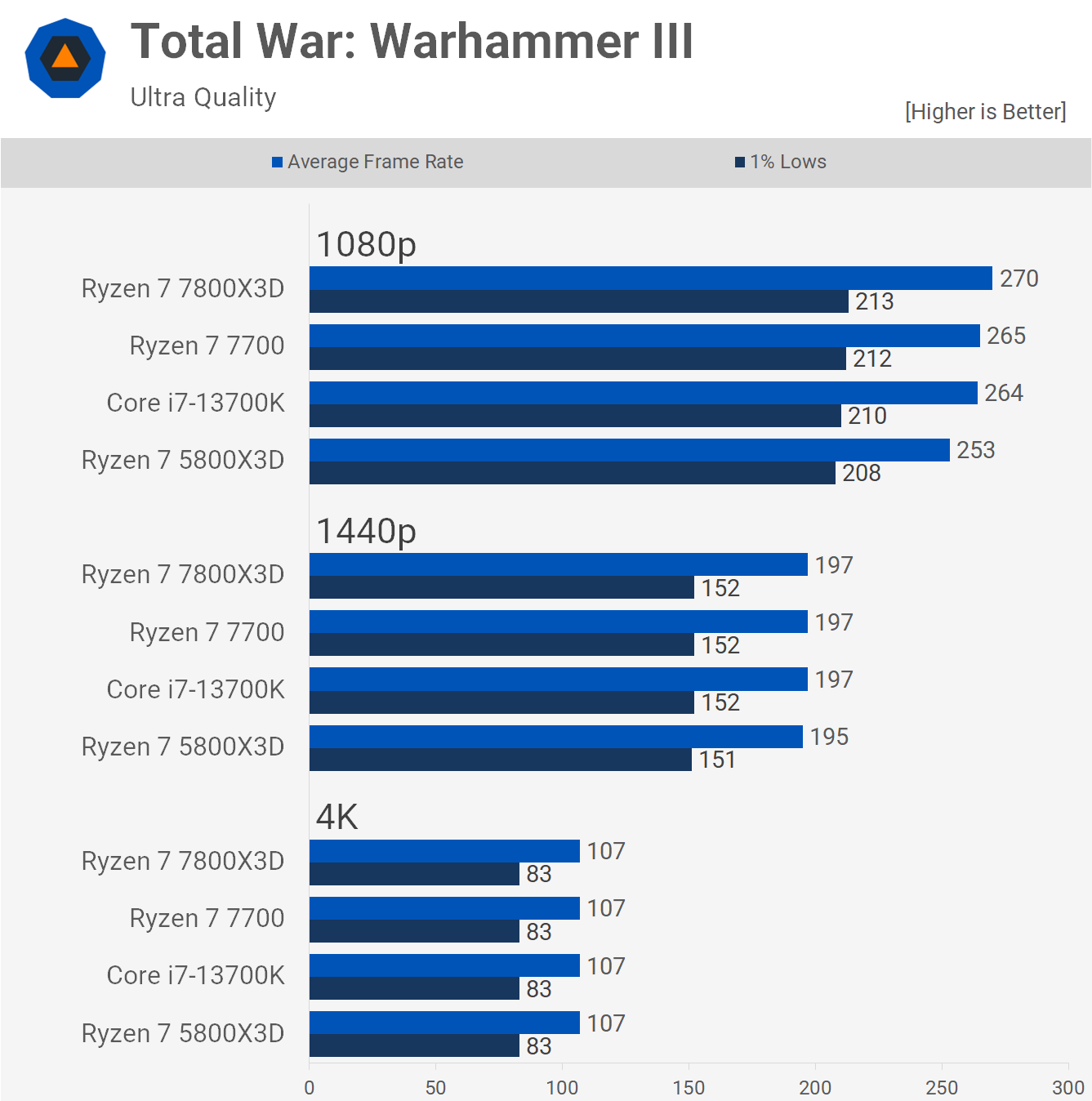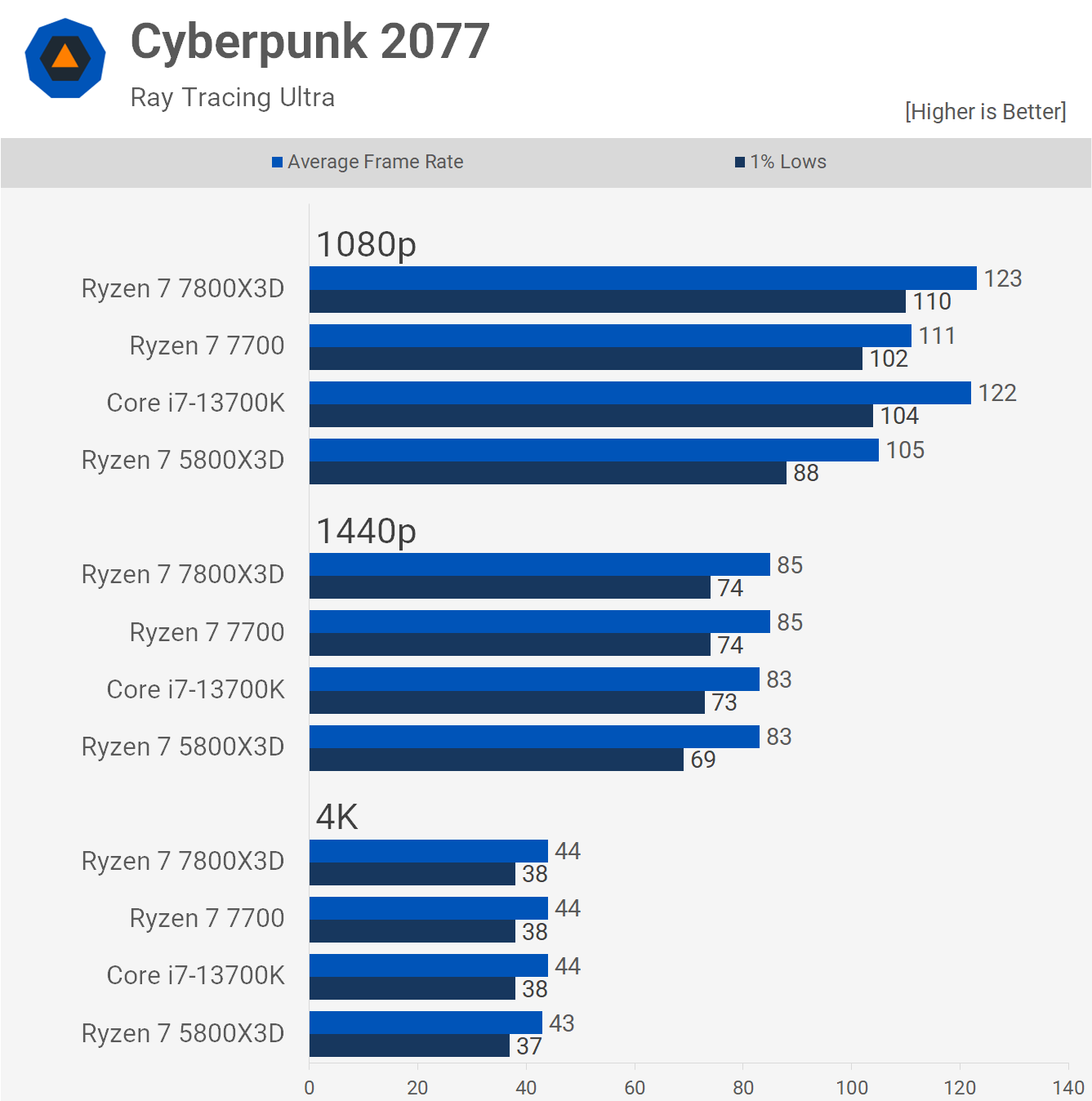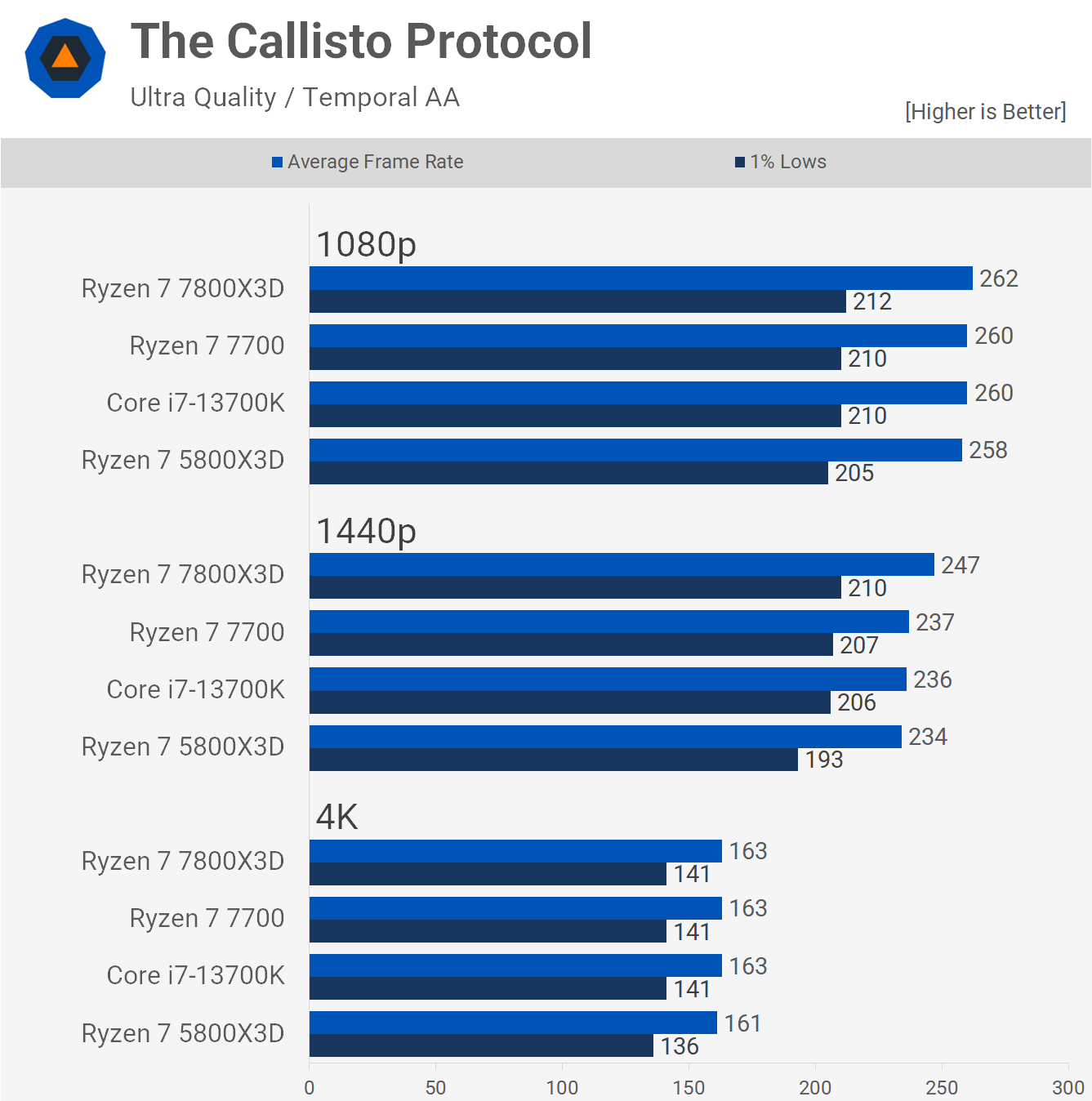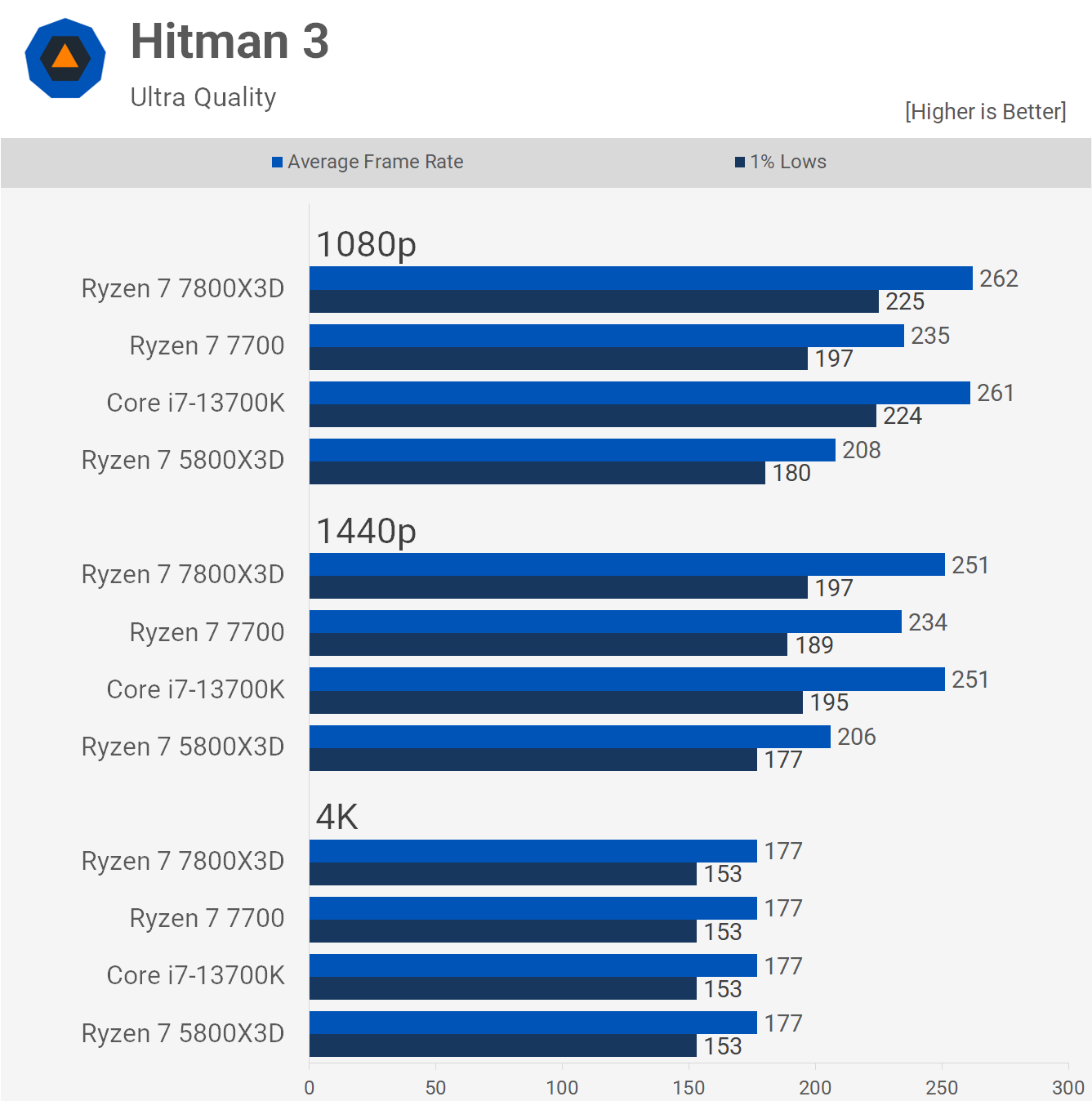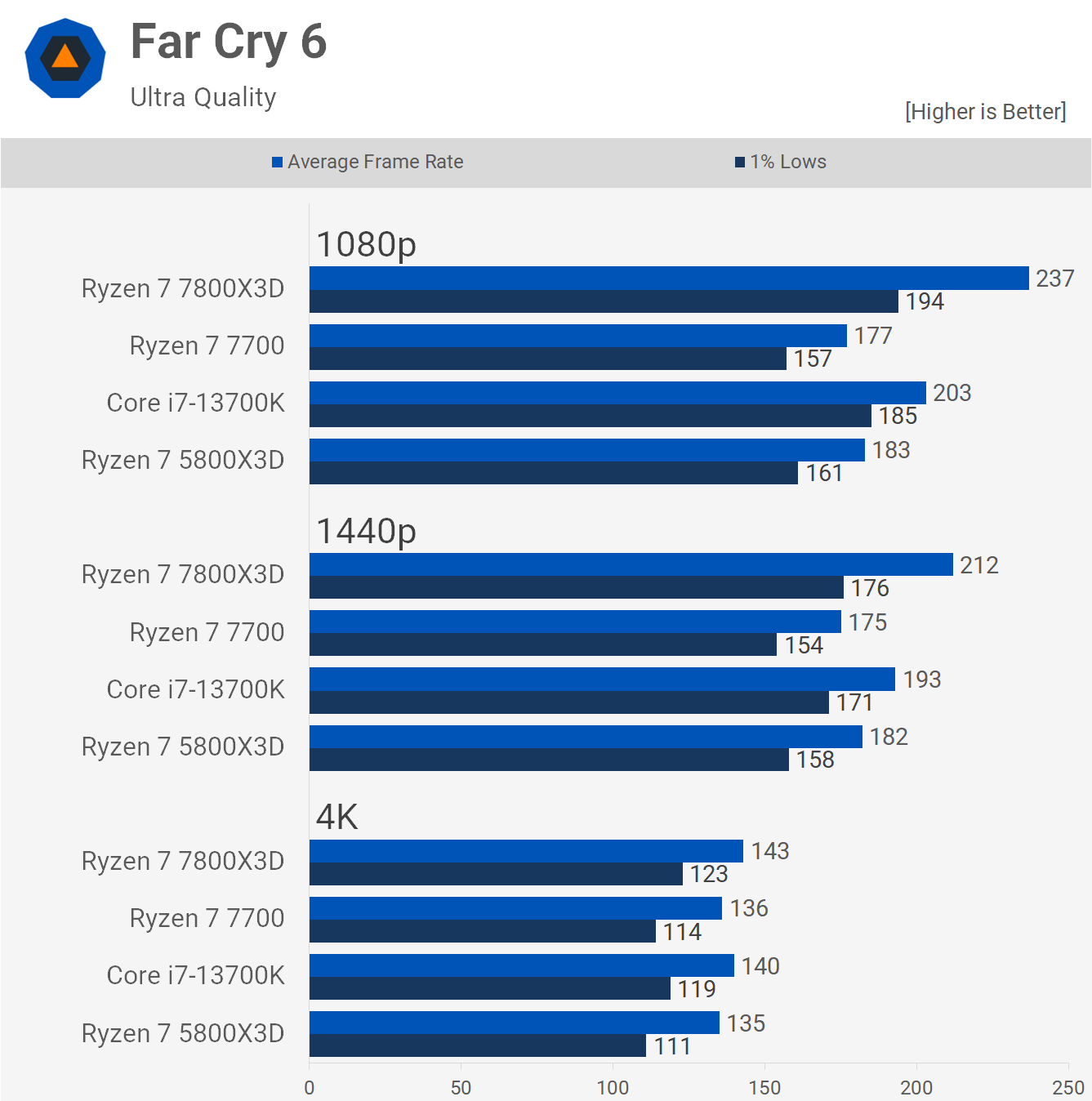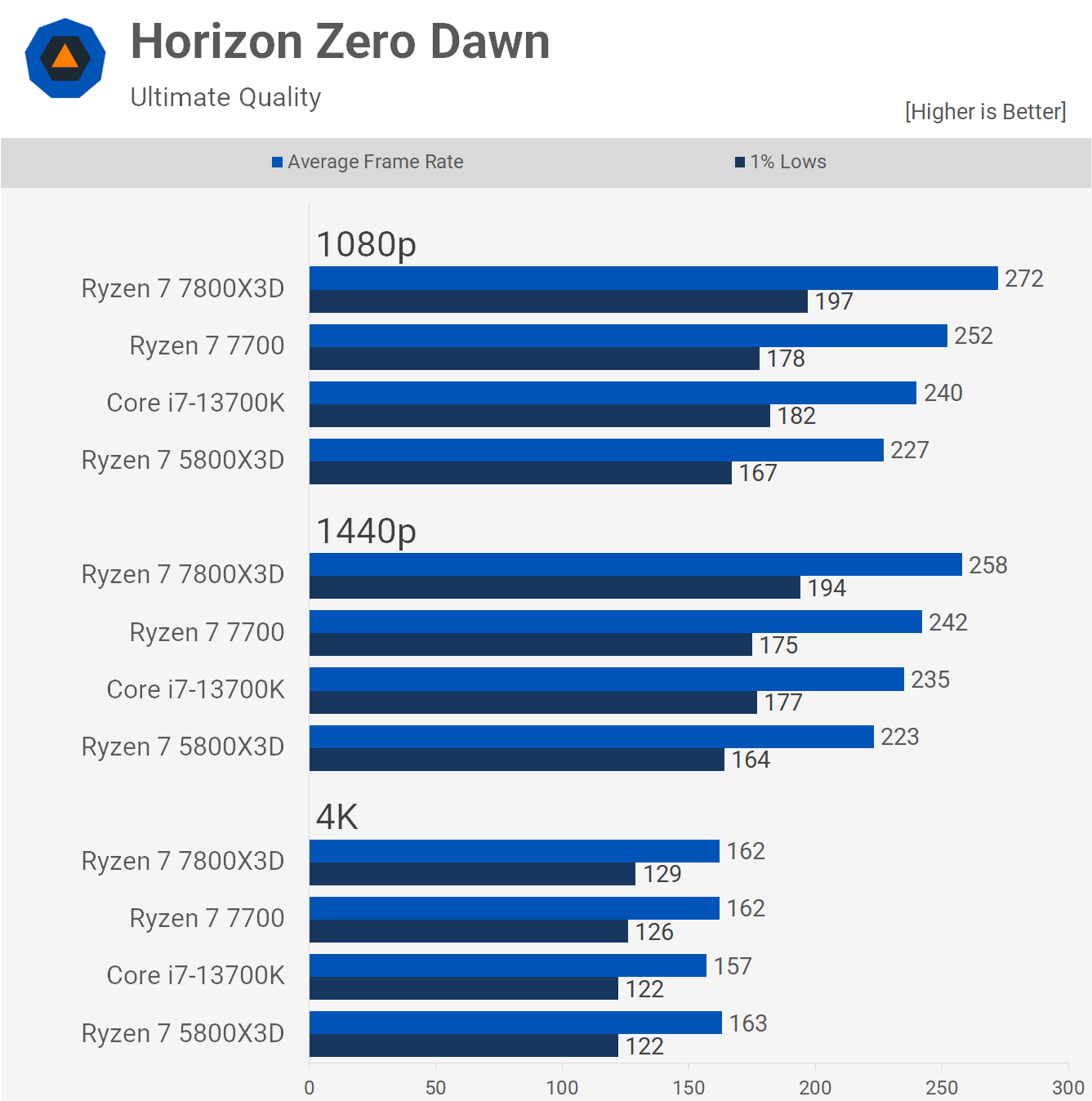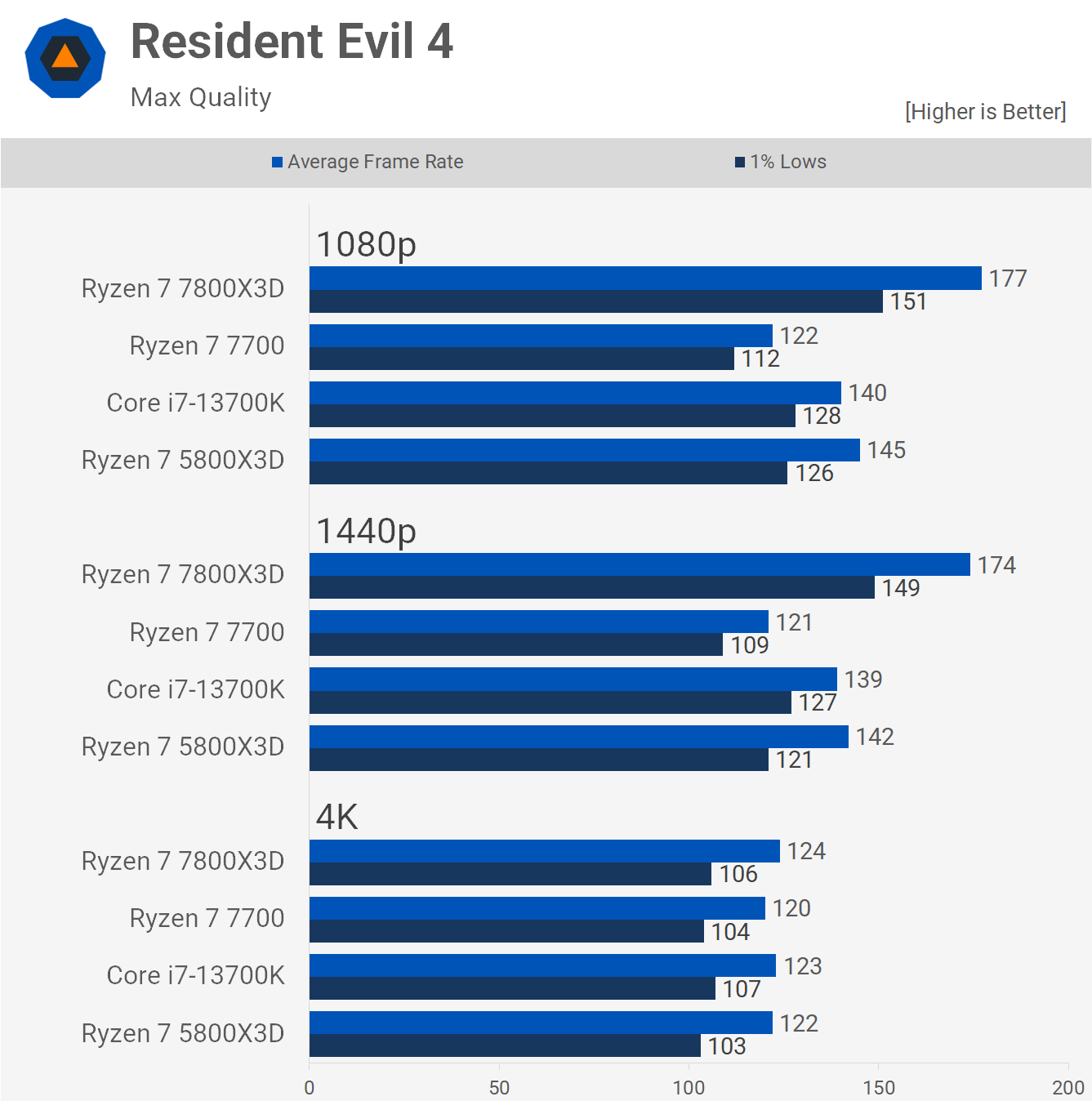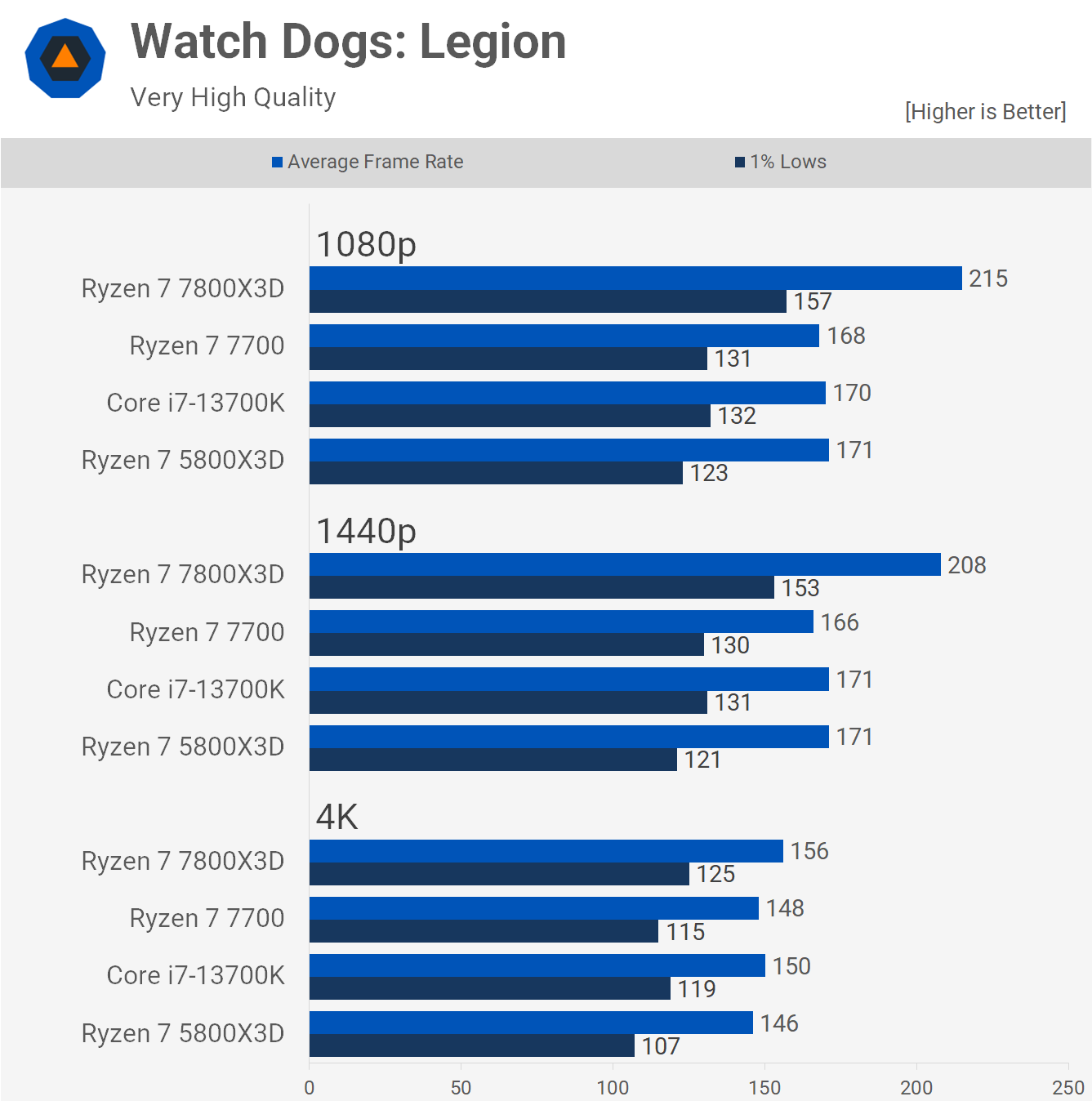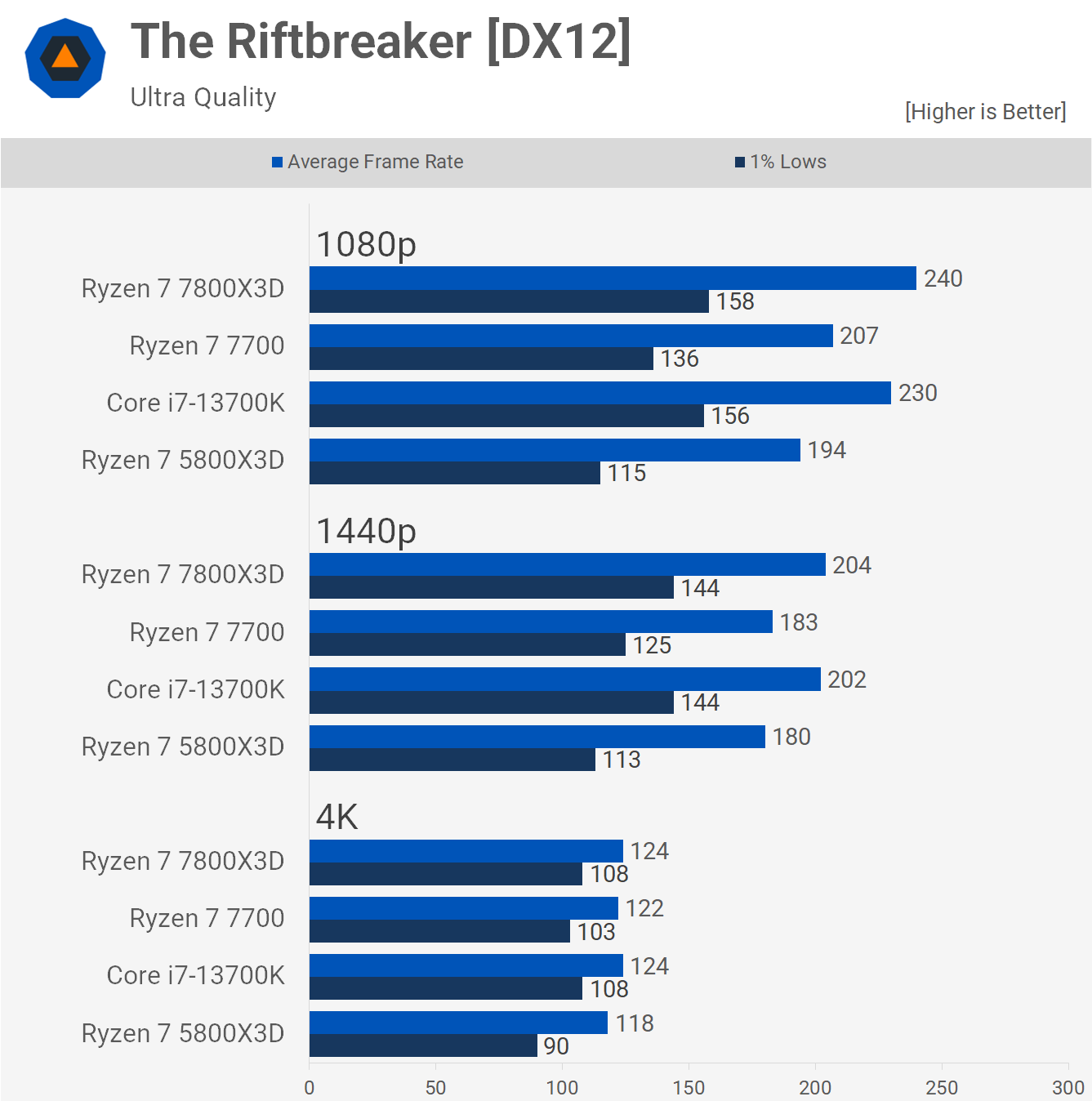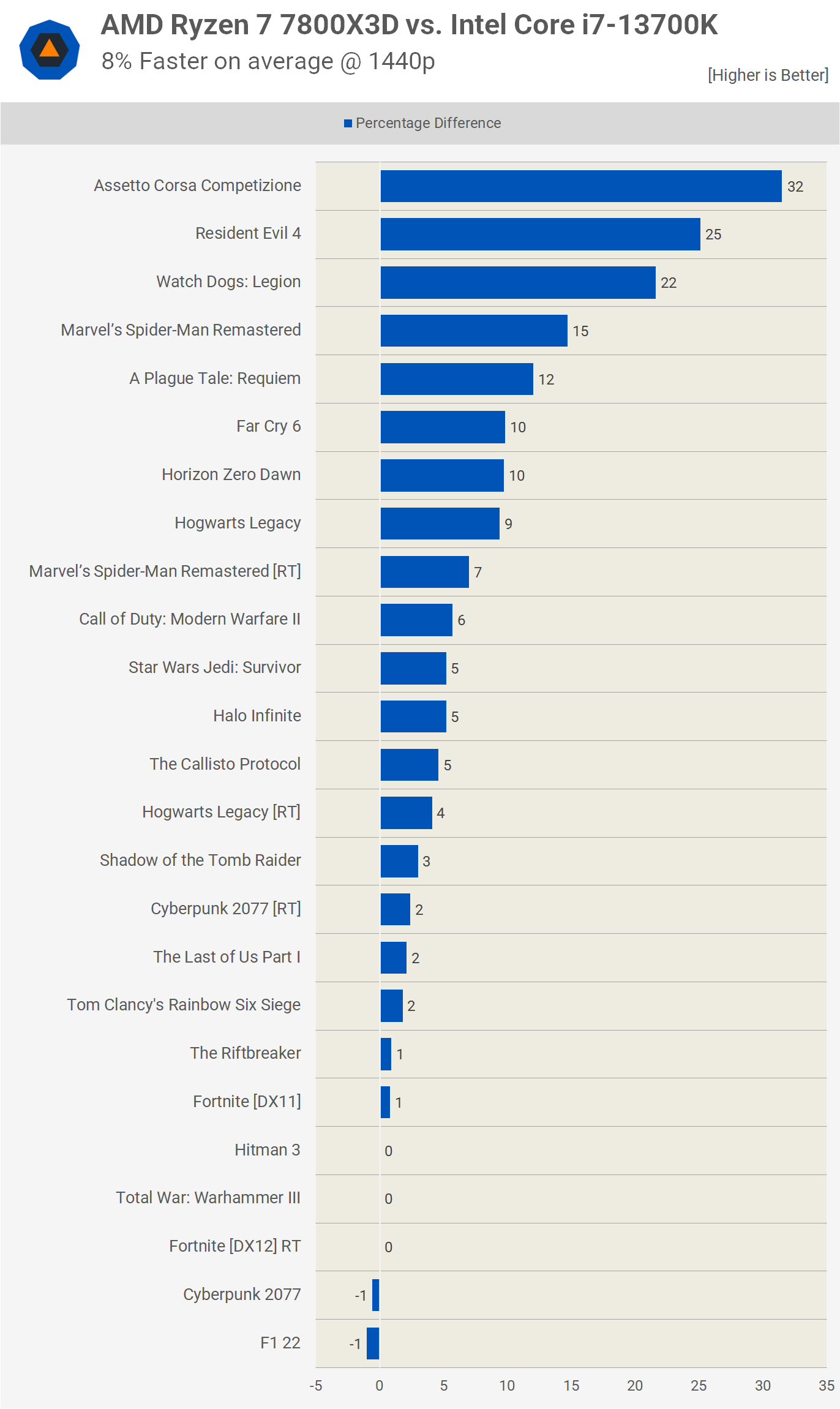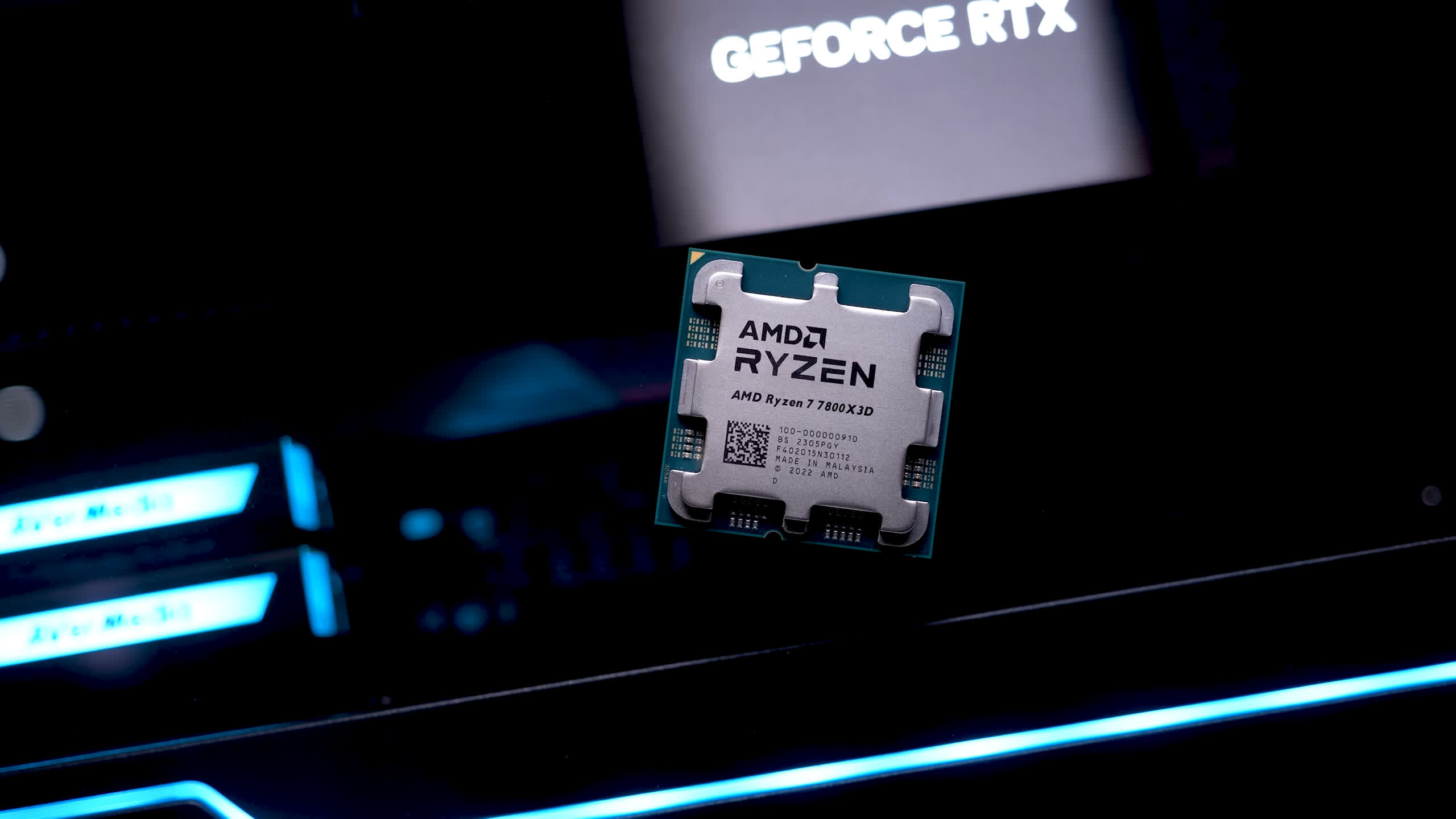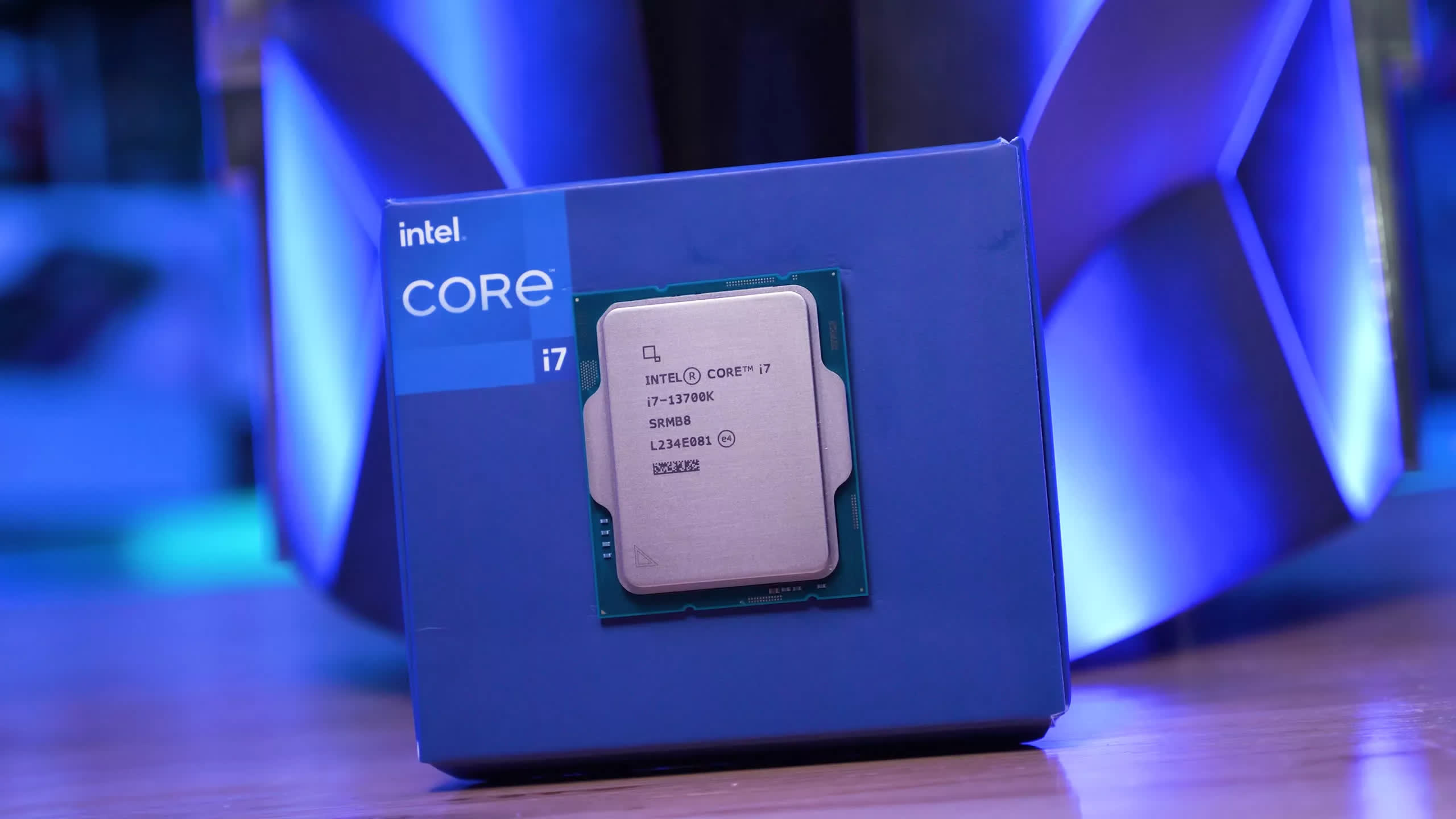It's time for a classic AMD vs. Intel head-to-head gaming battle, and for this one, we have the Ryzen 7 7800X3D and Core i7-13700K. As it stands, the Ryzen 7 component costs just $40 more than the Core i7, resulting in a close match in terms of pricing.
We're certain that in the near future, we'll also have a face-off with the more expensive 13900K for you, but for now, it's Ryzen 7 vs Core i7.
For testing, the 7800X3D was installed on the Gigabyte X670E Aorus Master using the latest F11c BIOS revision and DDR5-6000 CL30 memory. Meanwhile, the 13700K was benchmarked using the MSI MPG Z790 Carbon Wi-Fi with DDR5-7200 memory since the Intel CPU supports higher clocked memory, providing it with every opportunity possible.
On the GPU front, we used the Asus ROG Strix RTX 4090 OC graphics card to benchmark at 1080p, 1440p, and 4K.
Let's dive in...
Benchmarks
The Core i7-13700K demonstrates impressive performance in Hogwarts Legacy, delivering 12% more performance than the 7700 at 1080p. However, the real competitor here is the 7800X3D; in this match-up, the Ryzen 7 processor was 8% faster, averaging 128 fps. Similar margins were observed at 1440p, and it's not until we reach 4K that the 13700K and 7800X3D end up neck and neck.
Enabling ray tracing in Hogwarts Legacy amplifies the GPU bottleneck, but even then, the 7800X3D was still 10% faster at 1080p, although that margin reduced to just 4% at 1440p and essentially zero at 4K.
For testing Spider-Man Remastered, our first configuration uses the very high preset with RT effects disabled. In this case, the 7800X3D was 17% faster at 1080p and 15% faster at 1440p. However, by the time we reach 4K, the performance differences are entirely neutralized.
With ray tracing enabled, the results are somewhat more GPU limited. Still, the 7800X3D managed to be 9% faster at 1080p and 7% faster at 1440p. These aren't massive margins, but we were surprised to find that the 3D V-Cache CPU still had a 6% edge at 4K.
Once again, we find that performance in Fortnite is comparable using any of these modern high-end processors, and despite using an RTX 4090, the results are entirely GPU-limited with the Epic quality preset.
Given the circumstances, it's unsurprising that with ray tracing enabled, the game also proves to be heavily GPU-limited, with only a few frames distinguishing the best and worst outcomes at 1080p.
The 13700K and 7800X3D yielded similar results in The Last of Us Part I. AMD's Zen 4 processor was merely 3% faster on average, although 1% lows were 10% greater. At 1440p, we are almost entirely GPU-limited, and the same is true for the 4K data.
The 7800X3D shines in Star Wars Jedi: Survivor, delivering 21% more performance than the 13700K at 1080p. However, the Core i7 processor is also 22% faster than the Ryzen 7 7700, so AMD's 3D V-Cache plays a key role here. The margin shrinks to just 5% at 1440p and is null at 4K, but the CPU-limited margins are still noteworthy.
Similar to Fortnite, Halo Infinite doesn't significantly challenge modern high-end processors, so the Core i7-13700K and Ryzen 7 7800X3D are closely matched, with a minor 4% advantage going the way of the 7800X3D at 1080p. We observe a 15% improvement for the 1% lows, however. The Core i7 also struggles with 1% lows at 1440p, granting the Ryzen processors a 6% lead here, and by the time we reach the 4K resolution, the results are largely identical.
Warhammer III is another game that doesn't particularly challenge modern high-end processors, resulting in similar performance across the board. Even at 1080p, the 13700K and 7800X3D are neck and neck, with no more than a few frames separating them.
F1 22 can become more CPU-limited at 1080p, even with modern processors such as the 7800X3D and 7700. The 13700K performs slightly better, but even so, the 7800X3D was still 9% faster. That said, once we shift up to 1440p, the results are predominantly GPU-limited, which is also the case for the 4K data.
Moving on to Cyberpunk 2077, we have our first instance where Intel's 13700K outperforms the 7800X3D, delivering 3% more performance at 1080p. That margin then disappears at 1440p, and we see much of the same at 4K.
Enabling ray tracing sees the 13700K match the 7800X3D, resulting in a tie. Both performed slightly better than the standard Ryzen 7 7700 and significantly better than the 7800X3D, especially when comparing the 1% lows.
The Callisto Protocol is another game where we end up GPU-limited, or perhaps game engine-limited in this case, as the 1080p frame rates aren't much higher than what we see at 1440p.
Whatever the situation, there's no significant advantage to using one CPU over the other in this title.
Compared to standard non-3D V-Cache enabled Ryzen processors, the 7800X3D is very fast in Hitman 3. However, when compared to Intel's 13700K, it's not that impressive, only matching the Core i7 with 262 fps at 1080p. As a result, we find no separation between the two at 1440p, and, of course, 4K.
Next up, we have Far Cry 6, and here, the 7800X3D was good for 237 fps on average, making it 17% faster than the 13700K, indicating a solid performance boost. It was also 10% faster at 1440p and then just 2% faster at 4K, where the results are heavily GPU-limited.
Shadow of the Tomb Raider ran 8% faster using the 7800X3D compared to the 13700K, or 10% when looking at the 1% lows. That margin shrinks to 3% at 1440p and disappears at 4K, where we still saw 164 fps on average.
The 7800X3D can handle Rainbow Six Siege with an RTX 4090 at up to 649 fps on average, making it 26% faster than the 13700K. Comparing 1% lows, that margin decreases to 19%. At 1440p, they're neck and neck, and the same holds true for the 4K data.
Horizon Zero Dawn ran up to 13% faster using the 7800X3D, pumping out 272 fps on average at 1080p. As expected, the margin decreased at 1440p, but the 3D V-Cache Ryzen part was still 10% faster.
From previous tests, we know that ACC highly values cache, and AMD's 3D V-Cache works exceptionally well. As a result, the 7800X3D outperformed the 13700K by a 32% margin at 1080p and 1440p. It was even 19% faster at 4K, even when using the game's epic quality preset.
Resident Evil 4 heavily favors the 7800X3D. At 1080p, the Ryzen 7 processor was 26% faster than the 13700K and then 25% faster at 1440p, before the margins are largely eliminated by the GPU bottleneck at 4K.
The 7800X3D also displayed a significant performance advantage in A Plague Tale: Requiem, delivering 17% more frames on average at 1080p, 12% more at 1440p, and then we are entirely GPU-limited at the 4K resolution.
The 7800X3D also excels in Watch Dogs: Legion, delivering 215 fps on average, making it 26% faster than the 13700K. The Core i7 part was able to match the 7700 along with the previous generation 7800X3D. The margin at 1440p is similar at 22%, though by the time we reach 4K, the 7800X3D is just 4% faster.
The Riftbreaker performs well with Intel processors. Here we see the 13700K performing to a high standard, coming in just behind the 7800X3D, which was 4% faster at 1080p. Then we basically see no difference at 1440p and 4K.
Last up, we have Call of Duty: Modern Warfare II, where performance is fairly similar across all CPUs tested. The 7800X3D was just 10% faster than the 13700K at 1080p and then 6% faster at 1440p before becoming largely GPU-bound at 4K.
Performance Summary
Having analyzed the Ryzen 7 7800X3D and Core i7-13700K across a wide array of games, it's time to break down all the data and provide a comprehensive comparison of these CPUs.
Starting with the 1080p data we see on average the 7800X3D is 11% faster than the Core i7-13700K which is quite a bit more than the 6% margin seen in our day one review. That said we're testing with a lot more games now, and we've seen some performance changes due to BIOS updates, display driver updates and even game updates.
Out of 25 tests, we found margins of less than 5% in 10 of them, but we also encountered margins favoring the 7800X3D by more than 20% in 5 titles. In general, the 7800X3D delivers superior gaming performance than the 13700K, although the extent of the difference can vary depending on the game. There was only one instance where the 7800X3D was slower, falling short by a meager 3% margin in Cyberpunk 2077.
As expected, the margin narrows at 1440p, yet the 7800X3D still managed to be 8% faster on average. Even so, some margins exceeded 20% in games such as Watch Dogs: Legion, Resident Evil 4, and ACC. Nevertheless, in 15 examples, the margin was 5% or less, which we consider a tie.
At 4K, the only noteworthy margin appeared in the CPU-limited game ACC, where the 7800X3D was 19% faster. Beyond that, the margins remain in the single digits, and the vast majority are less than 5%.
Power Consumption
The 7800X3D clearly leads as the overall fastest gaming CPU, but the difference isn't always significant, making power consumption a potentially decisive factor. Notably, despite being faster in nearly all games, the 7800X3D generally uses much less power.
On average, the Core i7-13700K consumed up to 100 watts more power, peaking at a whopping 196 watts in The Last of Us Part 1. We also observed an increase of 158 watts in Cyberpunk 2077 for nearly identical performance.
For those concerned about power consumption, operating volume, CPU temperatures, or even room temperatures, the 7800X3D is the superior choice for power efficiency.
What We Learned
In summary, the Ryzen 7 7800X3D outshines its Core i7 competitor, making it the go-to choice for top-tier gaming performance at around $400. However, is it the best value for money?
The 7800X3D, priced at $450, is about $40 more expensive than the 13700K or $60 more than the KF version. The DDR-7200 CL34 memory used for testing the Core i7 processor is priced at $165, while the DDR5-6000 CL30 memory used for the 7800X3D testing costs $125. Moreover, plenty of motherboard options are compatible with both CPUs, with decent ones starting at around $150.
This implies that if one were to purchase the memory featured in this review alongside a $150 motherboard, both the 13700K and 7800X3D combination would amount to exactly $725, or $705 if we opted for the 13700KF.
However, the latter only results in a minimal 3% savings, which arguably doesn't justify forgoing the iGPU supporting features like QuickSync.
This indicates that in terms of pricing they are identical, or at least incredibly similar depending on the memory configuration. With that, we're finding it really difficult to find reasons to recommend the Core i7.
It's generally slower, consumes more power – significantly more in some cases, runs considerably hotter because of this, and might require a superior, more costly cooler to operate at the same volume. Although, one would likely pair either with a high-quality cooler, so this might not be a significant factor in pricing.
Considering all these factors, if we were to build a new gaming PC with a platform budget of around $700, we would unquestionably snap up the 7800X3D.
Shopping Shortcuts:
- AMD Ryzen 9 7800X3D on Amazon
- Intel Core i7-13700K on Amazon
- AMD Ryzen 9 7950X on Amazon
- AMD Ryzen 7 7700 on Amazon
- Intel Core i5-13600K on Amazon
Further Testing
Since we published this review, we have run additional benchmarks and new reviews around mainstream Ryzen CPUs. Here are featured articles you may be interested in:
